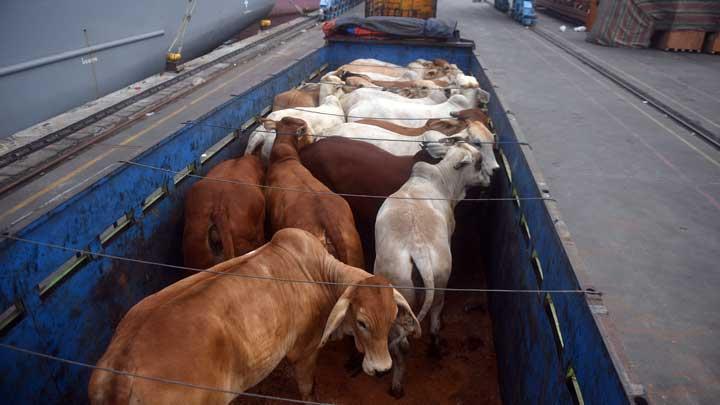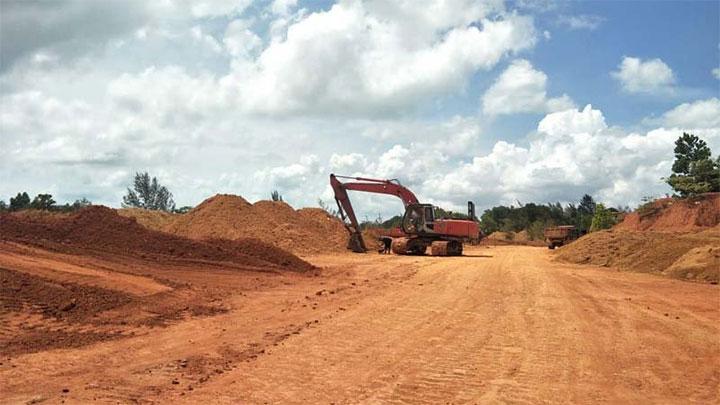Crunch Time in Fight Against Foot and Mouth Disease
Translator
Editor
29 May 2022 11:07 WIB

TEMPO.CO, Jakarta - Foot and mouth disease infecting cattle could acutely damage the ruminant livestock industry, with annual losses estimated at a total of Rp9.9 trillion.
Agriculture Minister Syahrul Yasin Limpo make this cautionary statement during a recent meeting with Commission IV of the House of Representatives.
Foot and mouth disease surfaced in Indonesia less than a month back. At first, it spread only in the provinces of East Java and Aceh at the start of May. However, by the end of the month, the disease had made its presence felt in 16 provinces in Indonesia.
According to the ministry’s data as per May 22, 2022, the disease spread in some 16 provinces and 82 districts and cities, with a total of 5,454,454 cattle infected and 20,723 falling sick.
Indonesia had been free from the disease in 1990 ever since the issue emerged in 1887. However, the disease re-emerged, changing such status.
The disease was caused by a virus. Although it was not zoonosis in nature, which means it would not spread from animal to human, the rapid animal-to-animal transmission could prove costly.
The transmission could occur either through direct contact or via airborne means. Not only from animal to animal, but it could also be transmitted through contact from a sick human to animal or from a sick animal to a healthy one without prior disinfection.
A veterinarian from the Bogor Agricultural Institute, Denny Widaya Lukman, stated that foot and mouth disease is an infectious ailment that attacks animals with split hoofs, such as cow, buffalo, camel, elephant, deer, goat, sheep, and pigs.
The infected animals would develop blisters on their tongue, gum, nose, and nails.
Despite the low mortality rate caused by the virus, this disease is highly contagious, with its morbidity rate reaching 100 percent.
Reports stated that the death rate was five percent at most, while in younger animals, it could reach 20 percent. The death was caused by the inability of the animal to either eat or drink, thereby leading to lack of nutrition.
“Animals infected with foot and mouth disease showed symptoms of blisters on the mouth as well as thick and foamy saliva around the mouth as well as wound on the legs,” Lukman stated.
The agriculture minister stated that the recovery rate for these infected animals was high, capped at 33 percent.
According to their data, of the total animals that fell ill, 6,896, or 33.29 percent, were cured; 162, or 0.78 percent, were slaughtered; and 142, or 0.69 percent, had died.
As the disease could not be transmitted to humans, it was possible to eat the infected animals, under the condition that they were properly cooked.
It was worth to note that the infected parts, such as the feet, tongue, lips, and internal organs, could not be consumed.
Yet it could not be denied that the outbreak would greatly impact the domestic production of meat and milk. Now that tens of thousands of cattle were sick, the decline in products was not so surprising.
Other losses include a decrease in exports caused by suspicions surrounding the quality of Indonesia’s products that are alleged to be contaminated by the disease.
It would also weaken the ruminant industry, and Indonesia would not have a good image among other countries.
A Rapid Response
Commission IV of the House of Representatives urged the government, through the Agriculture Ministry, to promptly address the national issue of foot and mouth disease.
The disease could only be handled by eradication via vaccine. Although the disease's death rate was low and the animals could make a recovery, the virus could transmit to all sorts of places, thereby causing other animals to fall sick instead.
Thus, vaccine was the only way to ensure Indonesia was free from the disease. Just like in 1974 when mass vaccination was conducted in order to eradicate the outbreak.
However, vaccination should not only be a one-time thing. It must be conducted annually until the disease is completely wiped off from Indonesia.
Minister Limpo reported that the Center of Veterinarian at the Agriculture Ministry had found the serotype of the foot and mouth disease spreading rampantly in Indonesia. This serotype would be used to create the vaccine.
The vaccine was targeted for completion in August 2022, and it would thereafter be administered en masse.
“God willing, (it would all be done) in a very short (period of) time. The Center of Veterinarian at the Agriculture Ministry is currently developing the foot and mouth disease vaccine, which is set for completion in four months or prior to August 2022,” he noted.
Apart from preventing infection through a stronger immune system provided by the vaccine, it could also be done by putting in efforts to prevent it from infecting cattle in the first place.
Head of the Research Center for Beef Cattle Research and Development at the Agriculture Ministry, Veterinatian Dicky M. Dikman M. Phill, stated that efforts ranging from maintenance to livestock health management could prevent the transmission of the disease among livestock.
Cultivation management was employed to produce healthy livestock. The maintenance could be done on an intensive, semi-intensive, and extensive basis.
"For outbreak areas, we (employed) an intensive system to press down the risk of airborne transmission. The foods given could be in the form of forage and concentrates that were tailored to the needs and production," he stated.
Cultivation could be improved by adopting biosecurity as an effort to prevent the spread of foot and mouth disease.
Biosecurity entailed physical and management efforts to minimize the risk of disease agents spreading in the farm, preventing the development of disease, and thwarting the transmission of disease agents from the farm.
“Biosecurity is vital, either by smallholder farms or private company farms. For housing, we (impose stricter regulations on) personnel going in and out of the cage. Guest visits or other visits are also prohibited until the epidemic subsides," he added.
Some of the facilities that were required to be readied, include disinfectants to be sprayed on arriving and departing vehicles; sanitation equipment for cage workers, such as lockers, bathrooms, and showers; spraying booths for officers; and cage sanitation.
Other necessary efforts entailed spraying insecticides to kill insects, flies, and other pests around the cattle pens.
This was done to keep the cage environment clean and prevent the spread of the disease.
Sick cattle must be treated immediately. Should there be livestock dying from foot and mouth disease, their corpses must be burned or buried immediately.
As for infected cattle, they were either slaughtered or had their infected tissues removed.
ANTARA
Click here to get the latest news updates from Tempo on Google News























